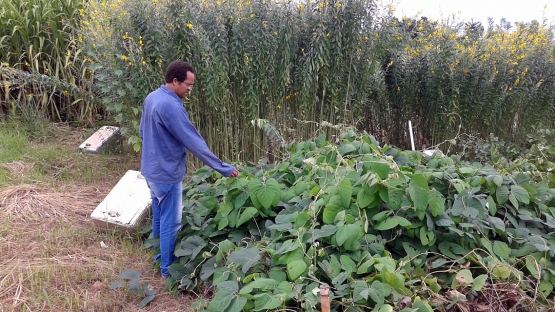International Atomic Energy Agency issued the following announcement on May 8.
Brazilian farmers are working with nuclear scientists to utilize organic farming techniques to increase their productivity while at the same time reducing their carbon emissions in a project coordinated by the IAEA in cooperation with the Food and Agriculture Organization of the United Nations (FAO). They use stable isotope techniques to verify the effectiveness of their organic farming practices, reducing their costs, while helping the environment.
Agriculture is a significant component of the Brazilian economy. The country is the world’s largest producer of coffee, orange juice and sugar and the second largest producer of soybeans and crop-based ethanol. Brazilian production of grain reached over 230 million tonnes in the 2016-17 growing season.
Such massive agricultural production requires a heavy supply of nitrogen, which used to be added in the form of chemical fertilizer. Fertilizers contribute to climate change by producing large amounts of greenhouse gases during the manufacturing process and again when they are applied to soil in excess of what is actually consumed by the plants.
Fertilizers containing synthetic nitrogen are also costly, so farmers in Brazil are moving towards the use of biological nitrogen fixation (BNF). This technique, known as green manuring, involves the capture of nitrogen from the air, rather than from chemical fertilizers.
“Recent studies in Brazilian agriculture show that over 76% of all nitrogen in harvested grain and cereals is derived from BNF, and less than 20% is from synthetic nitrogen fertilizers,” said Segundo Urquiaga, a research scientist at the Brazilian Agricultural Research Corporation. “The use of BNF via legume cultivation is now in full growth in Brazilian agriculture, particularly in central-west Brazil.”
Farmers plant various types of bean crops, including jack beans and velvet beans, that have bacteria in their roots which convert nitrogen from the air into a form suitable for consumption by other plants, fertilizing the soil. After the beans are harvested and the crop residue is left behind, primary crops such as grain and cereals are planted on the same field and benefit from nitrogen now in the soil, with only a minimal amount of chemical fertilizer required.
“The cost of organic manure in Brazil is estimated to be about US $1.00 per kg of N. If we consider not only the BNF associated to green manuring but all the economic benefits of BNF, that is, including soybean grain production, it is estimated that the replacement of chemical N sources by N derived from BNF in Brazilian agriculture can result in savings as high as US $13 billion per year,” said Urquiaga. “There has been a rapid growth of organic farming systems in Brazil,” said Urquiaga.
Limiting greenhouse gas emissions
Though it is considered necessary to use at least some chemical fertilizer for crop production to be economically viable, integrating BNF into commercial farming operations has the potential to significantly reduce greenhouse gas emissions by minimizing the need for such synthetic fertilizers.
The Brazilian government has committed to reducing greenhouse gas emissions by 43% by 2030, compared to 2005 levels, at the 2015 United Nations Climate Change Conference. Given that agriculture accounts for 24% of global greenhouse gas emissions, the expanding implementation of these farming practices based on the use of BNF efficient plants will help the country meet this target.
Addressing land degradation
In addition to increasing crop production in a sustainable manner, green manuring helps prevent land degradation by improving the overall health of the soil. “The green manures have been ‘feeding’ the soil, which helps forestall its degradation,” said Jose Donizetti, an agronomist at the green manuring company Piraí Sementes in Brazil. “A significant proportion of [Brazilian] soils are in an advanced stage of degradation due to intensive and improper use for agricultural activity [in the past].”
THE SCIENCE
To verify the effectiveness of green manuring, scientists use nuclear techniques involving stable isotopes. For example, scientists can track nitrogen-15 isotopes to confirm how much N is fixed by green manure or how well cash crops are absorbing nitrogen derived from green manuring. For this second purpose, they introduce samples of nitrogen-15 into the soil around the crops. Over a period of several months they observe how much nitrogen-15 is absorbed by the plants, which tells them how efficiently the plants are using the nutrients.
Another example of a nuclear technique to evaluate the benefits of green manures is the analysis of the isotope carbon-13 to determine how much carbon from green manures will be recycled and transformed into soil organic matter after repeated growth cycles contributing then to increase soil quality.
Original source can be found here.

Source: International Atomic Energy Agency




 Alerts Sign-up
Alerts Sign-up